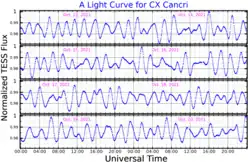28 Cancri
28 Cancri is a star system in the zodiac constellation of Cancer. It is a variable star with the designation CX Cancri, and is close to the lower limit of visibility with the naked eye, having a mean apparent visual magnitude of 6.05.[3] The annual parallax shift seen from Earth's orbit is 8.5 mas, which provides a distance estimate of about 384 light years. It is moving away from the Sun with a radial velocity of around +9 km/s.[6]
| Observation data Epoch J2000 Equinox J2000 | |
|---|---|
| Constellation | Cancer |
| Right ascension | 08h 28m 36.78530s[2] |
| Declination | +24° 08′ 41.7179″[2] |
| Apparent magnitude (V) | 6.05[3] |
| Characteristics | |
| Spectral type | F0 Vn[4] |
| U−B color index | +0.13[3] |
| B−V color index | +0.22[3] |
| Variable type | δ Sct[5] |
| Astrometry | |
| Radial velocity (Rv) | +9.0±4.3[6] km/s |
| Proper motion (μ) | RA: −30.946[2] mas/yr Dec.: −39.719[2] mas/yr |
| Parallax (π) | 8.4885 ± 0.1539 mas[2] |
| Distance | 384 ± 7 ly (118 ± 2 pc) |
| Absolute magnitude (MV) | 0.41[7] |
| Details | |
| Mass | 2.36±0.11[8] M☉ |
| Radius | 3.7[2] R☉ |
| Luminosity | 44[2] L☉ |
| Surface gravity (log g) | 3.61[2] cgs |
| Temperature | 7,516+52 −103[8] K |
| Metallicity [Fe/H] | +0.16[9] dex |
| Rotational velocity (v sin i) | 133[8] km/s |
| Age | 737[2] Myr |
| Other designations | |
| Database references | |
| SIMBAD | data |
Based upon proper motion variation, this is an astrometric binary system with high likelihood (99.8%).[11] The visible component has a stellar classification of F0 Vn,[4] indicating it is a F-type main-sequence star with "nebulous" lines due to rapid rotation. It is a Delta Scuti variable star with a period of 0.0960 days and an amplitude of 0.020 in magnitude.[12] With 2.4 times the mass of the Sun it is spinning with a high projected rotational velocity of 133 km/s. 28 Cancri is radiating roughly 44 times the Sun's luminosity from its photosphere at an effective temperature of around 7,516 K.
References
- "MAST: Barbara A. Mikulski Archive for Space Telescopes". Space Telescope Science Institute. Retrieved 8 December 2021.
- Vallenari, A.; et al. (Gaia collaboration) (2023). "Gaia Data Release 3. Summary of the content and survey properties". Astronomy and Astrophysics. 674: A1. arXiv:2208.00211. Bibcode:2023A&A...674A...1G. doi:10.1051/0004-6361/202243940. S2CID 244398875. Gaia DR3 record for this source at VizieR.
- Oja, T. (August 1991), "UBV photometry of stars whose positions are accurately known. VI", Astronomy and Astrophysics Supplement Series, 89 (2): 415–419, Bibcode:1991A&AS...89..415O.
- Cowley, A.; et al. (April 1969), "A study of the bright A stars. I. A catalogue of spectral classifications", Astronomical Journal, 74: 375–406, Bibcode:1969AJ.....74..375C, doi:10.1086/110819.
- Dubath, P.; et al. (2011), "Random forest automated supervised classification of Hipparcos periodic variable stars", Monthly Notices of the Royal Astronomical Society, 414 (3): 2602–2617, arXiv:1101.2406, Bibcode:2011MNRAS.414.2602D, doi:10.1111/j.1365-2966.2011.18575.x, S2CID 118560311.
- de Bruijne, J. H. J.; Eilers, A.-C. (October 2012), "Radial velocities for the HIPPARCOS-Gaia Hundred-Thousand-Proper-Motion project", Astronomy & Astrophysics, 546: 14, arXiv:1208.3048, Bibcode:2012A&A...546A..61D, doi:10.1051/0004-6361/201219219, S2CID 59451347, A61.
- Anderson, E.; Francis, Ch. (2012), "XHIP: An extended hipparcos compilation", Astronomy Letters, 38 (5): 331, arXiv:1108.4971, Bibcode:2012AstL...38..331A, doi:10.1134/S1063773712050015, S2CID 119257644.
- Zorec, J.; Royer, F. (2012), "Rotational velocities of A-type stars. IV. Evolution of rotational velocities", Astronomy & Astrophysics, 537: A120, arXiv:1201.2052, Bibcode:2012A&A...537A.120Z, doi:10.1051/0004-6361/201117691, S2CID 55586789, A120.
- Netopil, Martin (4 May 2017). "Metallicity calibrations for dwarf stars and giants in the Geneva photometric system". Monthly Notices of the Royal Astronomical Society. 469 (3): 3042–3055. arXiv:1705.00883. Bibcode:2017MNRAS.469.3042N. doi:10.1093/mnras/stx1077. eISSN 1365-2966. ISSN 0035-8711.
- "28 Cnc". SIMBAD. Centre de données astronomiques de Strasbourg. Retrieved 2018-02-09.
- Frankowski, A.; et al. (March 2007), "Proper-motion binaries in the Hipparcos catalogue. Comparison with radial velocity data", Astronomy and Astrophysics, 464 (1): 377–392, arXiv:astro-ph/0612449, Bibcode:2007A&A...464..377F, doi:10.1051/0004-6361:20065526, S2CID 14010423.
- Rodríguez, E.; et al. (June 2000), "A revised catalogue of δ Sct stars", Astronomy and Astrophysics Supplement, 144 (3): 469–474, Bibcode:2000A&AS..144..469R, doi:10.1051/aas:2000221.
